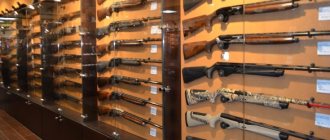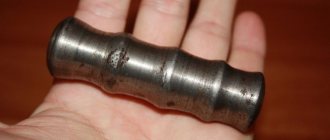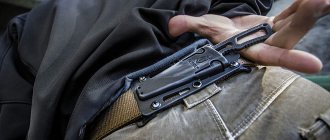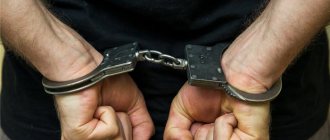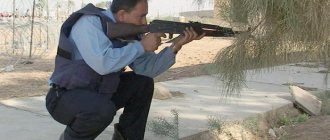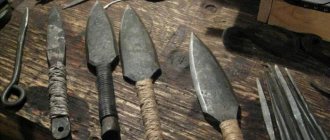Archaeologists are still finding prototypes of bladed weapons that served primitive people. Of course, they look primitive and far from the modern look, but in those distant times there was simply no other way. It was a means for hunting, butchering animal carcasses, and also for protection from attacks from other tribes and wild animals. Over time, it improved, and modern, familiar species appeared.
Before the development of firearms, cold was the main thing in defense, attack and simply helping a person. Now edged weapons serve as auxiliary weapons, complementing the capabilities of small arms. Also, edged weapons can serve as equipment for a military uniform and national costume, or can be a reward.
What is considered a bladed weapon?
All products related to the hunting, military or sports field, the action of which is not associated with any energy carriers or explosives, capable of causing death or injury to a person , are classified as edged weapons.
This definition does not include kitchen, stationery, garden, penknives and other household tools. If you look at it, injury can be caused by any object.
The production, storage, and use of all weapons is regulated by Federal Law No. 150. This legislative act clearly defines what is a bladed weapon, who, where and how has the right to use it. In Art. 1 Federal Law No. 150 states that edged weapons are a product used to hit a target through close contact with it and using muscular force. Current legislation clearly defines the circle of persons who have the authority to use such items to solve certain problems.
Permits for storing and carrying bladed weapons are not always required, for example, if such weapons are classified as sports weapons. A license is required if a citizen purchases piercing and cutting objects as a hunter or “wearer” of national costumes. And striking examples of this can be the Cossacks, whose constant attribute is the Cossack saber, representatives of the peoples inhabiting the Caucasus, where it is customary to carry a dagger from a young age.
If a hunter has a license to carry and store a gun, then this document will be sufficient for the smooth acquisition of a full-fledged hunting knife . The following may carry edged weapons without violating the legislation of the Russian Federation:
- Professional athletes.
- Hunters and reindeer herders.
- Law enforcement officers (on duty).
- Military personnel, including those who are on well-deserved rest. If these persons have an award or trophy bladed weapon, then they can only carry it if they have permits.
- Security guards and forwarders involved in the protection or transportation of inventory items.
- RAS employees carrying out some types of work.
- Antique collectors who take part in any specialized events.
Important! If the rules for wearing chemical weapons on its owner are not observed, according to Art. 20.8 of the Administrative Code, penalties are imposed. The fine varies from 500 to 2000 rubles. The dangerous object is subject to confiscation.
Signs of edged weapons
In Russia they are regulated by GOSTs: R51500-99 and R51548-2000.
Signs of edged weapons are a whole list of parameters:
- Length. If an object is classified as a chemical weapon, then the length of its blade cannot be less than 9 cm. This parameter is determined as follows: the distance from the base of the handle to the tip of the tip is measured. If the length of the blade part is less than 1 mm, then such a knife is not considered a bladed weapon within the meaning of the law.
- Blade thickness. This value can be measured by the height of the butt (the part of the blade opposite the tip). If at the widest part of the butt the thickness of the blade is more than 2.6 mm, then this is a cold blade. Official manufacturers of products intended for free use prefer to produce knives with a smaller thickness, which eliminates the possibility of any punishment for its owner.
- Steel hardness. If the blade is made of mild steel, then it is not able to provide the desired effect, therefore, such a knife will be classified as a household item. In Russia, for blades, the hardness of steel must be at least 25 units on the Rockwell scale.
- Handle design. Signs of a bladed weapon are the presence of a sub-finger recess or limiter in the design, the height of the protrusion of which should be half a centimeter. When there are 2 stops on the handle, the total height should still be half a centimeter (each of them can be no more than 2.5 mm high). The depth of the sub-finger notch should also be 5 mm, but if there are several of them, then the depth of each of them cannot be more than 4 mm.
- Blade sharpness. This indicator also falls under GOST standards, but such signs of edged weapons are determined by the old antiquated method: a good knife should cut down a birch branch 12 mm thick with one stroke, and the presence of nicks and other defects on the cut is not allowed.
- Penetration depth. This parameter cannot be less than 20 mm.
This is interesting! What is needed for a permit and how to obtain a weapons license
Types of bladed weapons
Melee weapons are classified according to several criteria. For example, it can be domestic and imported, civilian, combat, service, contact or thrown (or thrown), standard, combined, camouflaged, industrially manufactured, homemade, converted.
The classification of edged weapons looks like this:
- Percussion. This type is the least common, all over the world, and is often called this: impact-crushing weapons. Almost all of it is made in a handicraft way, and particularly striking examples are the mace, flail, club, brass knuckles, club, handheld, and cue ball. The production of such products is carried out by criminal elements of all stripes, and for this they use improvised materials: scraps of metal pipes, shovel cuttings, fittings, etc. Each product is considered a bladed weapon if it falls within the parameters defined by law (hardness of materials, presence of modified handles, overall dimensions).
- Throwing. Also a rare type of chemical weapons, but very effective in combat, as it has a large range of destruction. These are crossbows, bows and throwing knives that are small in size and have a balanced shape.
- Stabbing. These are types of weapons, the use of which allows you to inflict damage on a person with one blow. That is, you can hit one vital organ to incapacitate the enemy. It is noteworthy that piercing weapons are divided into piercing-cutting and piercing-cutting. It can be single-edged or double-edged. All types of knives are classified as single-edged, and swords, daggers, and dirks are classified as double-edged.
- Chopping and cutting. These are reeds, sabers, halberds, battle axes.
- Slashing-piercing and at the same time chopping-cutting (large daggers, cutlasses, scimitars, broadswords, checkers).
- A piercing weapon with a long shaft. Combat pitchfork, spear, protazan, trident, lance, angon.
- Short-shafted piercing weapon (the length of the wooden handle cannot exceed 120 cm). Dart, pernach, sulitsa.
- Chopping polearm. This is a poleaxe, a battle ax and everything that has a shaft and can inflict chopped wounds.
Attention! There is a chemical substance that cannot be classified as a specific type or species, because it can fit several definitions at once. For example, a spear is a polearm throwing and piercing weapon at the same time.
What is the problem with examination?
The problem is that a private examination can cost more than the sword itself. Therefore, as a last resort, it’s a good idea to have at least one necessary conclusion for several owners of swords of the same type, or at least a similar printout (although it’s not a fact that this will be enough):
By the way, lovers of historical edged weapons are strongly recommended to at least familiarize themselves with and keep at hand the same GOST R 51215-98 “Melee weapons. Terms and Definitions".
A very useful document, from it you can glean a lot of useful information - find out how the types of edged weapons differ according to the principle of action and their specific samples. For example, coinage and klevets, from the point of view of the law, differ only in the word “Russian” in the definition of klevets.
In this sense, this GOST is very useful, because contains many definitions, although it is not a 100% comprehensive and exhaustive source. For example, the striker of the same coinage does not actually have to be attached to the shaft with an eye, as indicated in GOST.
There are even some discrepancies with the Federal Law “On Weapons,” but they are insignificant, and the Federal Law still has greater force.
Which knife is considered a bladed weapon?
Not all types of knives are related to chemical weapons. In order for a product to be recognized as such, it must have all the design features inherent in this type of weapon. That is, the length of the blade is 9 cm or more, a certain thickness, hardness and sharpness of the blade, etc. Sometimes, in order to determine which knife is considered a bladed weapon, the intervention of experts is required. For example, a folding knife with a blade even 15 cm long does not qualify as a chemical weapon, nor does a product with a hook on the butt or without a point (it is deliberately filed down so that it is impossible to identify the item as prohibited).
There is a whole list of items related to chemical weapons that are completely prohibited for use on the territory of the Russian Federation, and there are items that are subject to some restrictions.
It follows that even with permission, a citizen does not have the right to purchase them and use these products for their intended purpose. This applies to both ordinary citizens and law enforcement officers.
This is interesting! Traumatic, gas and civilian self-defense weapons that do not require a license
Prohibited types of weapons are not legally sold in stores , and these include boomerangs, flails, shuriken, brass knuckles and other dangerous objects intended for throwing and having a shock-crushing effect. The sports core is not one of them.
“Butterfly” and “butterfly” knives with a blade length of more than 9 cm are illegal. It is worth taking into account that knives and similar dangerous objects cannot be taken with you when going to places with large crowds of people, and such things are prohibited from being sent by post.
If a citizen is the owner of an antique stiletto, dirk, ax or other item made before 1945, then he does not need any permission to store them, since all of these are antique edged weapons . A more complete definition of this can be found in Federal Law No. 113. Hunting knives and other certified weapons purchased with licenses have a serial number.
Important! Melee weapons of this type are stored in a safe, and control over compliance with the conditions is entrusted to the local commissioner. Carrying chemical weapons within a populated area is prohibited, and no licenses provide such a right.
How to use the Cossack whip today
Whips in their modern form, without metal weights, are used by public Cossack organizations as a traditional attribute, an indication of belonging to the Cossack family. It can be used as a weapon of measured impact if representatives of Cossack organizations are involved in maintaining order or guarding the border.
A whip can be used for self-defense, carried without permission, because it is not a weapon. Fits behind your belt or in your pocket, does not attract attention, and is easy to take out after certain workouts. A whip cannot inflict serious wounds, much less kill, making it difficult to exceed the level of necessary self-defense. The whip is always ready for battle; storage does not require a safe, like weapons, or special care.
The Cossack whip was once an integral attribute of the Cossack; it served to control a horse, and, on occasion, could become a military weapon. Today it is more of a decoration that is used by modern Cossacks as a traditional item.

